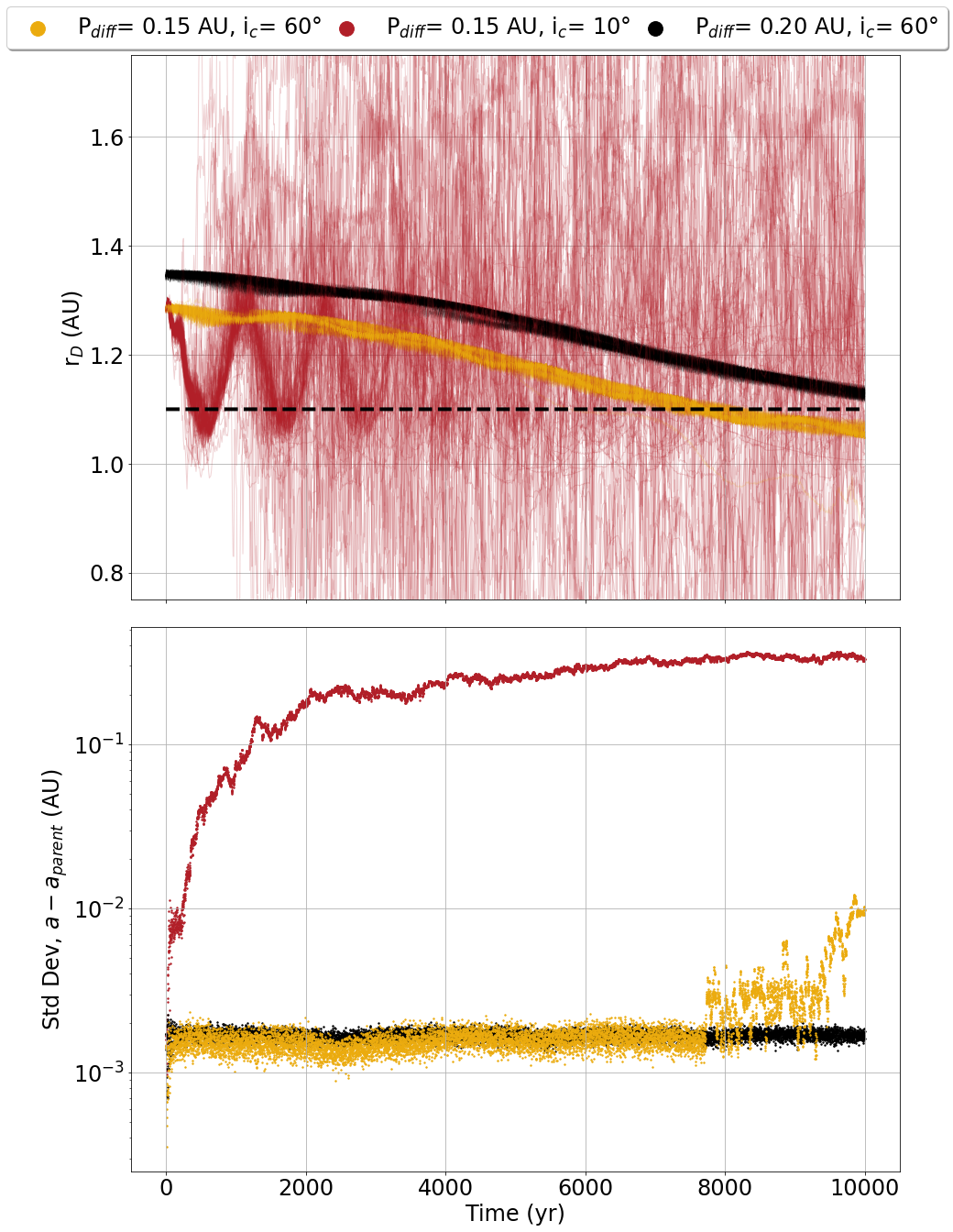A Numerical Study of Near-Earth Asteroid Family Orbital Dispersion
- Armagh Observatory and Planetarium, United Kingdom of Great Britain – Northern Ireland (alice.humpage@armagh.ac.uk)
We have completed a study which aims to guide future searches for near-Earth asteroid (NEA) families. The discovery of NEA families would help understand the formation, composition, and dynamical properties of NEAs [1][2], and with 100,000 potential new NEAs from Vera Ruben Observatory’s LSST [3], an efficient search will need to be completed. We have run n-body simulations of model NEA families with a wide range of orbital parameters and properties, to find those which cause the dispersion of families to be slowest, and our results are as follows:
The standard deviation of the orbital elements are significantly affected by the oscillations caused by the Kozai-Lidov effect [4], as changes in the family’s eccentricity, and thus the radius from the Sun at the ascending and descending nodes, will bring their orbits closer to those of the nearest planet. How quickly this occurs is affected by the inclination and the proximity to the nearest planet. Families with smaller inclinations will have faster Kozai-Lidov oscillations, and the closer a family is to a planet, the more quickly the oscillations will bring them together. A comparison of how this affected our models can be seen in Fig. 1.
We have also studied the effects of mean-motion resonances on the orbital dispersion of NEA families. Due to the previous work on a pair found in the 5:3 Venus MMR [5][6], we placed our models within, and near, this resonance. We found that dispersion is slower when breakup occurs within the resonance, if all family members remain within immediately after breakup. This is again due to the Kozai-Lidov oscillations, which appear to slow within the MMR. However, though the close approaches are delayed, once they do happen, we observe a larger dispersion increase than for the models placed outside of the resonance.
The D-criterion [7][8] has been used frequently to search for NEA families, and gives a value which represents the closeness of two objects’ orbits. We have analysed its performance within the 5:3 Venus MMR, and found that the Drummond D-criterion value for a pair is smaller for around 40,000 years longer than for a pair placed outside of the MMR.
We conclude that future searches should focus on NEA families at high inclination and far from the nearest planet, and within strong MMRs.

Figure 1 Top: the time evolution of the radius at the descending node of the simulated cluster rD, where the coloured lines show three models with different initial inclination ic, and Pdiff, the difference between initial planet and particle perihelion, indicated by the legend. The radius of the nearest planet’s orbit at the same angle as the parent body rD is indicated by a black dashed line. Bottom: the standard deviation of the difference between the semi-major axis of each particle and the parent body, for the three models.
Bibliography
[1] Schunová E., Granvik M., Jedicke R., Gronchi G., Wainscoat R., Abe S., 2012, Icarus, 220, 1050–1063
[2] Fu H., Jedicke R., Durda D. D., Fevig R., Scotti J. V., 2005, Icarus, 178, 434–449
[3] Jones R. L., et al., 2018, Icarus, 303, 181–202
[4] Naoz S., 2016, Annual Review of Astronomy and Astrophysics, 54, 441
[5] de la Fuente Marcos C., de la Fuente Marcos R., 2018, Monthly Notices of the Royal Astronomical Society: Letters, 483, L37–L41
[6] Moskovitz N. A., et al., 2019, Icarus, 333, 165
[7] Southworth R. B., Hawkins G. S., 1963, Smithsonian Contributions to Astrophysics, 7, 261
[8] Drummond J. D., 1981, Icarus, 45, 545–553
How to cite: Humpage, A. and Christou, A.: A Numerical Study of Near-Earth Asteroid Family Orbital Dispersion, Europlanet Science Congress 2024, Berlin, Germany, 8–13 Sep 2024, EPSC2024-910, https://doi.org/10.5194/epsc2024-910, 2024.